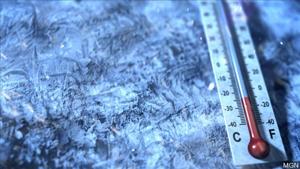
CHICAGO (AP) — A blast of polar air enveloped much of the Midwest on Wednesday, closing schools and businesses and straining infrastructure across the Rust Belt with some of the lowest temperatures in a generation.
The deep freeze snapped rail lines and canceled hundreds of flights in the nation’s third-largest city, which was as cold as the Arctic. Heavily dressed repair crews hustled to keep water mains and gas pipes working.
Chicago dropped to a low of around minus 23 (minus 30 Celsius), slightly above the city’s lowest-ever reading of minus 27 (minus 32 Celsius) from January 1985. Milwaukee had similar conditions. Minneapolis recorded minus 27 (minus 32 Celsius). Sioux Falls, South Dakota, saw minus 25 (minus 31 Celsius).
Wind chills reportedly made it feel like minus 50 or worse and kept most people at home. Chicago streets were largely deserted, and trains and buses operated with few passengers on what would normally be a busy weekday. The hardiest commuters ventured out only after covering nearly every square inch of flesh against the extreme chill, which froze ice crystals on a person’s eyelashes and eyebrows.
The Postal Service took the rare step of suspending mail delivery in many places, and in southeastern Minnesota, even the snowplows were idled by the weather.
The bitter cold was the result of a split in the polar vortex, a mass of cold air that normally stays bottled up in the Arctic. The split allowed the air to spill much farther south than usual. In fact, Chicago was colder than the Canadian village of Alert, one of the world’s most northerly inhabited places. Alert, which is 500 miles from the North Pole, was a couple of degrees warmer.
Officials in dozens of cities were focused on protecting vulnerable people from the cold, including the homeless, seniors and those living in substandard housing.
At least eight deaths were linked to the system, including a man struck by a snowplow in the Chicago area, a young couple whose SUV struck another on a snowy road in northern Indiana and a Milwaukee man who froze to death in a garage.
Aside from the safety risks and the physical discomfort, the system’s icy grip also took a heavy toll on infrastructure. Amtrak canceled all train service to or from Chicago, one of the nation’s busiest rail hubs. Chicago commuter trains that rely on electricity were also shut down after the metal wires that provide their power contracted, raising the wires and throwing off connections.
Ten diesel-train lines in the Metra network kept running, but crews had to heat vital switches with gas flames and watched for rails that were cracked or broken. When steel rails break or even crack, trains are automatically halted until they are diverted or the section of rail is repaired, Metra spokesman Michael Gillis explained.
A track in the Minneapolis light-rail system also cracked, forcing trains to share the remaining track for a few hours.
In Detroit, more than two dozen water mains froze. Customers were connected to other mains to keep water service from being interrupted, Detroit Water and Sewerage spokesman Bryan Peckinpaugh said.
Most mains were installed from the early 1900s to the 1950s. They are 5 to 6 feet underground and beneath the frost line, but that matters little when temperatures drop so dramatically, Peckinpaugh said.
On a typical winter day, the city has five to nine breaks, with each taking about three days to fix. But those repairs will take longer now with the large number of failures to fix, he added.
Detroit is in the second year of a $500 million program to rehab the water and sewer system. Last year, 25 miles of water mains were replaced.
“Water pipes are brittle. The more years they’ve gone through the freeze-thaw cycle, the more likely stress and strain,” said Greg DiLoreto, a volunteer with the American Society of Civil Engineers and chair of its committee on American infrastructure.
Pipes laid a century ago have far exceeded the life span for which they were designed, said DiLoreto, who described the aging process as “living on borrowed time.”
“When we put them in — back in the beginning — we never thought they would last this long,” he said.
The same freeze-thaw cycle beats up concreate and asphalt roads and bridges, resulting in teeth-jarring potholes.
“You won’t see them until it starts warming up and the trucks start rolling over the pavement again,” said DiLoreto who is based in Portland, Oregon.
Thousands of utility customers were without electricity after high winds also caused trees and branches to fall into power lines, especially in the south Chicago suburbs. The ComEd utility in northern Illinois said crews restored power to more than 42,000 customers and were working to restore another 9,400.
Duke Energy was working to restore power to about 5,200 customers on Indianapolis’ north side and adjacent areas of Hamilton County. Another 1,000 outages were reported near Kokomo, Indiana, about 40 miles north of Indianapolis. The utility was investigating the cause of the outages.
Low temperatures can cause overhead wires to contract, said Otto Lynch, chief executive of Power Line Systems in Madison, Wisconsin, and a member of the American Society of Civil Engineers.
“The tension goes way up the wire and gets tighter and causes poles to break,” Lynch said. “The wires are usually not going to break. It’s really dependent on how the line was designed. Fifty years ago, they didn’t do a whole lot of engineering. The old lines may not have been designed” for such extreme temperatures.
Consumers Energy asked customers throughout Michigan’s Lower Peninsula to cut back on natural gas usage to make sure there is enough fuel in the lines. The Jackson, Michigan-based utility expects 3 billion cubic feet of natural gas will be used Wednesday. Usage on a typical winter day is about 2 billion cubic feet.
———
Williams reported from Detroit. Associated Press writers Caryn Rousseau in Chicago, Rick Callahan in Indianapolis, Mike Householder in Detroit, David Koenig in Dallas, Blake Nicholson in Bismark, North Dakota, and Gretchen Ehlke in Milwaukee contributed to this story.


